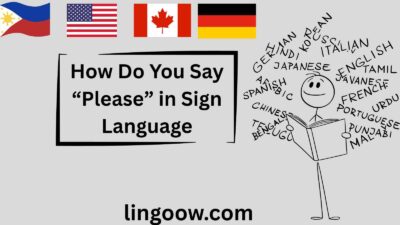Imagine walking into a room full of people from different parts of the world—each speaking a language you don’t understand.
The air is filled with unfamiliar sounds, yet when one person looks at you, smiles, and gently moves their hands to sign “How are you?”
you understand instantly. In that moment, no words are needed—just human connection.
“How are you?” is one of the simplest and most powerful expressions of care across all cultures. It’s not just a question—it’s a bridge, an invitation to connect. In spoken languages, it changes shape and sound, but in sign language, it becomes beautifully universal—a gesture that transcends barriers of sound and speech.
Let’s explore how people express “How are you?” through sign language and its spoken counterparts across different cultures. Along the way, we’ll discover how a simple phrase carries centuries of empathy, warmth, and belonging.
How to Say “How Are You” in Sign Language
In American Sign Language (ASL), “How are you?” is expressed using two main signs:
- “How” – Start with both hands curved and facing down near your chest, knuckles together. Twist your hands outward slightly.
- “You” – Point directly toward the person you’re addressing.
Together, the phrase becomes a fluid, graceful motion—one that reflects genuine care and curiosity.
In other sign languages, like British Sign Language (BSL), Australian Sign Language (Auslan), or French Sign Language (LSF), gestures differ, but the spirit remains the same. This diversity mirrors the way spoken languages evolve across borders.
Reference Table: How to Say “How Are You” Around the World
| Language | Phrase | Cultural Insight |
|---|---|---|
| American Sign Language (ASL) | 🤟 (Gesture) | Focuses on facial expression and sincerity more than words. |
| British Sign Language (BSL) | 🤲 (Different gesture) | Uses both hands in a circular motion—very expressive. |
| French | Comment ça va ? | Often used casually, showing France’s conversational charm. |
| Spanish | ¿Cómo estás? | A warm and personal greeting used even among strangers. |
| Italian | Come stai? | Said with emotion—Italians often pair it with touch or eye contact. |
| German | Wie geht’s? | Direct yet caring, reflecting German efficiency with warmth. |
| Japanese | お元気ですか (O-genki desu ka?) | Polite and formal—shows deep respect for others’ well-being. |
| Mandarin Chinese | 你好吗 (Nǐ hǎo ma?) | Literally “You good?”—emphasizes harmony and balance. |
| Hindi | आप कैसे हैं (Aap kaise hain?) | Reflects the Indian culture of respect through honorifics. |
| Swahili | Habari gani? | Translates to “What’s the news?”—a lively, community-based greeting. |
| Arabic | كيف حالك (Kayfa haluk?) | A heartfelt inquiry often followed by blessings. |
| Zulu | Unjani? | Deeply communal—asks about one’s well-being in connection to others. |
| Maori | Kei te pēhea koe? | A phrase of warmth and belonging, reflecting Maori kinship values. |
| Hawaiian | Pehea ‘oe? | Soft and melodic, often said with a smile and aloha spirit. |
| Cherokee | Osda dagwu? | Connects physical and spiritual wellness—used with sincerity. |
European Languages: Emotional Warmth Meets Social Grace
In Europe, “How are you?” is more than a greeting—it’s part of the rhythm of everyday politeness.
- In France, “Comment ça va ?” can be both casual (Ça va ?) or caring (Comment allez-vous ?). The tone matters as much as the words.
- In Italy, “Come stai?” often comes with touch—a hand on the shoulder or a hug.
- In Germany, “Wie geht’s?” is concise but meaningful, usually followed by genuine listening.
Across Europe, the phrase signals not just curiosity, but social connection—an acknowledgment that someone matters.
Asian Languages: Respect and Harmony in Every Word
Asian greetings often carry a deep sense of respect and collective identity.
- In Japan, “O-genki desu ka?” reflects the nation’s emphasis on politeness and care.
- In China, “Nǐ hǎo ma?” centers on balance and emotional well-being.
- In India, “Aap kaise hain?” changes depending on the level of respect and familiarity.
In Arabic-speaking countries, “Kayfa haluk?” is more than a question—it’s often followed by warm blessings like “Alhamdulillah” (Thanks be to God).
In many Asian cultures, asking “How are you?” isn’t always about the literal answer—it’s about showing kindness and belonging.
African Languages: Connection Through Community
In Africa, greetings are a ritual of connection.
- In Swahili, “Habari gani?” invites a story—it literally means “What’s the news?”
- In Zulu, “Unjani?” carries communal meaning; to ask about one person is to care about their family too.
- In Yoruba, “Bawo ni?” opens the door to a longer conversation.
African cultures see greetings as social glue—they sustain relationships, peace, and respect.
Indigenous & Island Languages: Spiritual Connection Through Words
For Indigenous peoples and island cultures, language is sacred—it connects the person to nature and spirit.
- The Maori greeting “Kei te pēhea koe?” expresses deep empathy.
- In Hawaiian, “Pehea ‘oe?” carries the aloha spirit—love, compassion, and unity.
- Among the Cherokee, “Osda dagwu?” links physical and emotional wellness.
In these communities, asking “How are you?” is not just about health—it’s about the balance between people, land, and spirit.
Cultural Insights: The Evolution of a Universal Greeting
The idea of asking about someone’s well-being has existed for thousands of years. Ancient civilizations used phrases equivalent to “How are you?” as part of ritual exchanges. In ancient Greece, greetings often involved asking about one’s “psyche” (soul). In Egypt, people asked about “ka” (spirit).
In sign languages, this tradition continues—except gestures, not words, carry emotion. A simple hand motion can express compassion, interest, and kindness, proving that human empathy doesn’t need sound to exist.
Proverbs About Greetings Around the World
- Arabic: “A greeting is the key to the heart.”
- Swahili: “He who greets is not a stranger.”
- Chinese: “A kind word warms three winter months.”
- Cherokee: “Words have power; use them to heal.”
- Italian: “Chi domanda, impara.” — “He who asks, learns.”
These sayings remind us that greetings—whether spoken or signed—are small acts of love that ripple across humanity.
FAQs
1. Why do many languages have similar ways to say “How are you”?
Because the need to connect emotionally is universal. Cultures developed their own sounds or gestures for empathy and care.
2. What is the oldest known version of “How are you”?
Ancient Greek and Sanskrit texts contain early versions of greetings tied to spiritual well-being.
3. Are sign languages the same worldwide?
No, each region has its own sign language, but the emotions they convey—care, curiosity, connection—are universal.
Conclusion: A World Connected by Care
Whether spoken in Italian, signed in ASL, or sung in Swahili tones, “How are you?” reminds us that kindness is a universal language. It transcends sound, culture, and geography—uniting us through empathy.
Next time you see someone, try asking “How are you?”—in any language or sign. You might just brighten their day, and in doing so, make the world feel a little smaller, a little kinder, and a lot more connected. 🌍💛




